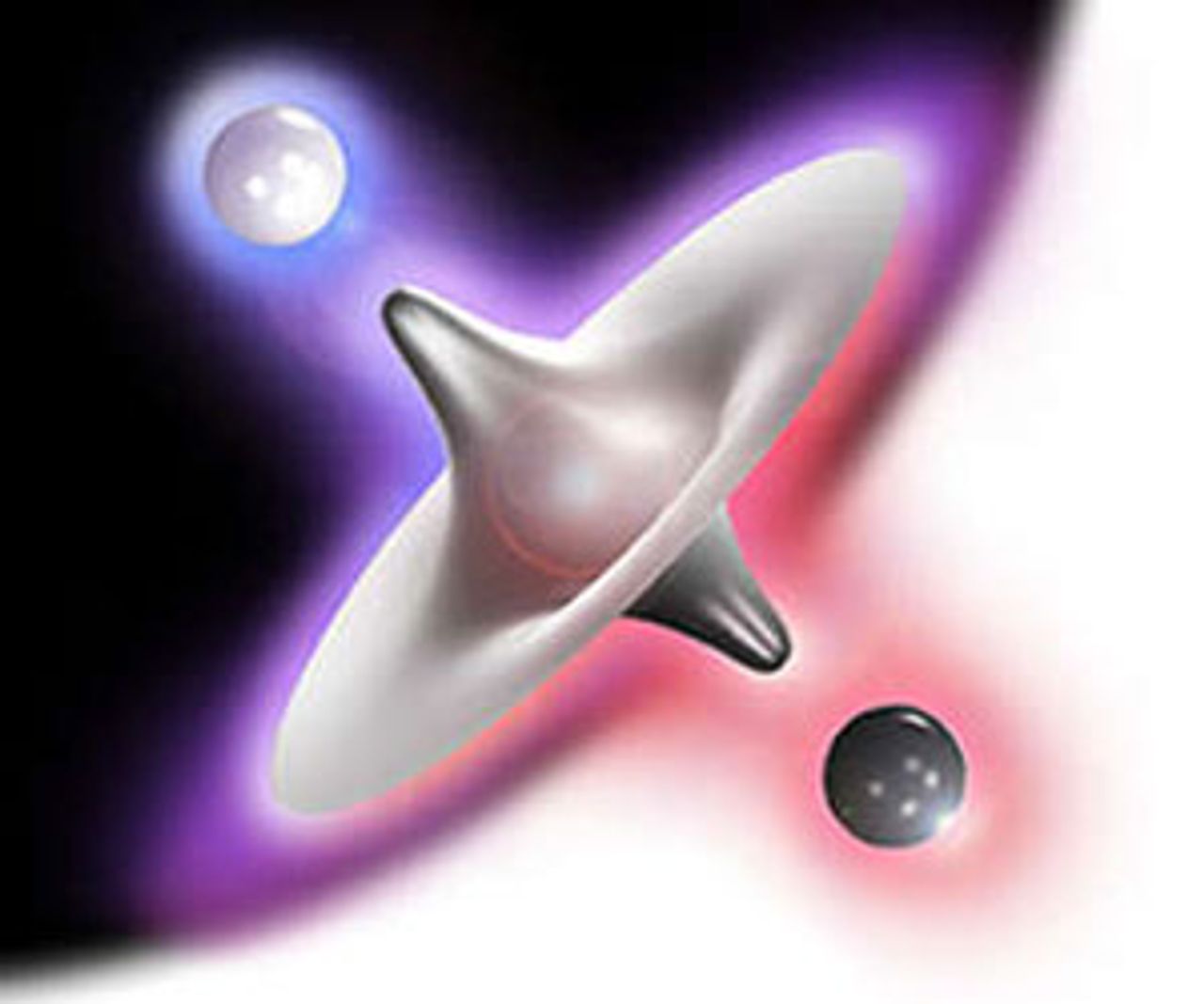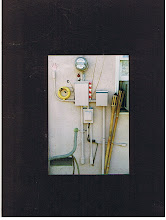CERN experiment weighs antimatter to unprecedented precision By Bryan Dyne
 Artist rendition of the creation of a particle
Artist rendition of the creation of a particle
and antiparticle [Photo: CERN]The CERN experiment ACACUSA has weighed antiprotons to an unprecedented level of accuracy. The results, published in Nature [1], do not reveal a significant difference in mass between the antiproton and its proton counterpart.
Though this answer is to be expected based on current physics, it does not help understand why matter dominates almost exclusively over anti-matter in our universe. This preponderance of matter over anti-matter is one of the main unknowns in contemporary physics.
The first three decades of the 20th century were just as tumultuous in physics as they were in politics. Experimental evidence from 1880 onward hinted that the classical understanding of physics, Newton's mechanics and Maxwell's electrodynamics, was inadequate at explaining newly discovered phenomenon, in particular the nature of light. In researching light, physicists discovered special relativity, general relativity and quantum mechanics.
By the mid-1920s, enough experimental evidence had been recorded to placate the opponents of relativity and quantum mechanics was developing into a regime that defied classical intuition. What was clearly understood, however, was that relativity and quantum mechanics must be compatible with each other for physics to remain consistent. Paul Dirac emerged as the physicist who, utilizing the works of his colleagues over the past decade, first combined special relativity and quantum mechanics [2].
Dirac's paper was a brilliant advance for understanding the universe. However, an odd result came from the equations he derived. It seemed as if something that was termed “negative” energy could exist. What is negative energy? Negative mass? Negative motion? This question spurred more research into the newly developing field and Dirac answered it three years later.
With assistance from Robert Oppenheimer, Dirac realized that instead of having negative mass, such particles would be better described as having normal mass, but with opposite charge. In addition, the “anti-particles,” when they come into contact with their normal counterparts, would annihilate, with both particles converting their mass wholly into energy.
While this solved the absurdity of negative mass, it posed a cosmological question many years later. When particles are created in accelerators, they are created in pairs, one normal matter, one antimatter. There is always a balance, a symmetry. How then does the universe exist? If antimatter and matter are created in equal parts, how did matter survive the origins of the universe? An asymmetry in the creation of matter and antimatter must exist.
Masaki Hori led the latest experiment in attempting to uncover this asymmetry between matter and antimatter. In the asymmetry, it is suspected that the mass of antimatter differs ever so slightly from normal matter. Discovering this was Hori's goal. The team started from the known mass ratio of the proton to the electron, which is 1836, and calculated the mass ratio of the antiproton and electron.
To perform such a feat, the team used a modified Helium atom. Normally, the Helium atom consists of a nucleus of two protons and two neutrons surrounded by two electrons. Hori stripped away one of the electrons and instead placed a negatively charged antiproton using CERN's antiproton decelerator. The effect of this is two-fold. First, due to the electron already around the nucleus, the antiproton will not immediately annihilate with a proton in the nucleus. This allows for two fine-tuned laser pulses to be aimed at the atom, causing the antiproton to annihilate. The information collected from these annihilations allows the mass ratio between the antiproton and electron to be calculated.
When all was said and done, the results indicated that the mass ratio of the antiproton and proton to an electron agree to ten decimal places, well within the experimental error. Differences between the charge of the antiproton and electron were also measured this way, and achieved similar results.
Though the results did not announce a breaking of the internal symmetries of physics, they did provide new constraints on the symmetry breaking that is expected to be found. In addition, the techniques developed by Mori's team allow for even more precise measurements of the mass of the antiproton. These will no doubt lead into ever more in depth searches into the nature of matter, antimatter and the mysteries surrounding both.
[1] Masaki Hori, Anna Sótér, Daniel Barna, Andreas Dax, Ryugo Hayano, Susanne Friedreich, Bertalan Juhász, Thomas Pask, Eberhard Widmann, Dezső Horváth, Luca Venturelli, Nicola Zurlo. Two-photon laser spectroscopy of antiprotonic helium and the antiproton-to-electron mass ratio .
[2] To this day, general relativity and quantum mechanics have not been merged. The search for a theory of 'quantum gravity' is an extremely active topic within the physics community.
By Bryan Dyne
26 August 2011
 Artist rendition of the creation of a particle
Artist rendition of the creation of a particle and antiparticle [Photo: CERN]
Though this answer is to be expected based on current physics, it does not help understand why matter dominates almost exclusively over anti-matter in our universe. This preponderance of matter over anti-matter is one of the main unknowns in contemporary physics.
The first three decades of the 20th century were just as tumultuous in physics as they were in politics. Experimental evidence from 1880 onward hinted that the classical understanding of physics, Newton's mechanics and Maxwell's electrodynamics, was inadequate at explaining newly discovered phenomenon, in particular the nature of light. In researching light, physicists discovered special relativity, general relativity and quantum mechanics.
By the mid-1920s, enough experimental evidence had been recorded to placate the opponents of relativity and quantum mechanics was developing into a regime that defied classical intuition. What was clearly understood, however, was that relativity and quantum mechanics must be compatible with each other for physics to remain consistent. Paul Dirac emerged as the physicist who, utilizing the works of his colleagues over the past decade, first combined special relativity and quantum mechanics [2].
Dirac's paper was a brilliant advance for understanding the universe. However, an odd result came from the equations he derived. It seemed as if something that was termed “negative” energy could exist. What is negative energy? Negative mass? Negative motion? This question spurred more research into the newly developing field and Dirac answered it three years later.
With assistance from Robert Oppenheimer, Dirac realized that instead of having negative mass, such particles would be better described as having normal mass, but with opposite charge. In addition, the “anti-particles,” when they come into contact with their normal counterparts, would annihilate, with both particles converting their mass wholly into energy.
While this solved the absurdity of negative mass, it posed a cosmological question many years later. When particles are created in accelerators, they are created in pairs, one normal matter, one antimatter. There is always a balance, a symmetry. How then does the universe exist? If antimatter and matter are created in equal parts, how did matter survive the origins of the universe? An asymmetry in the creation of matter and antimatter must exist.
Masaki Hori led the latest experiment in attempting to uncover this asymmetry between matter and antimatter. In the asymmetry, it is suspected that the mass of antimatter differs ever so slightly from normal matter. Discovering this was Hori's goal. The team started from the known mass ratio of the proton to the electron, which is 1836, and calculated the mass ratio of the antiproton and electron.
To perform such a feat, the team used a modified Helium atom. Normally, the Helium atom consists of a nucleus of two protons and two neutrons surrounded by two electrons. Hori stripped away one of the electrons and instead placed a negatively charged antiproton using CERN's antiproton decelerator. The effect of this is two-fold. First, due to the electron already around the nucleus, the antiproton will not immediately annihilate with a proton in the nucleus. This allows for two fine-tuned laser pulses to be aimed at the atom, causing the antiproton to annihilate. The information collected from these annihilations allows the mass ratio between the antiproton and electron to be calculated.
When all was said and done, the results indicated that the mass ratio of the antiproton and proton to an electron agree to ten decimal places, well within the experimental error. Differences between the charge of the antiproton and electron were also measured this way, and achieved similar results.
Though the results did not announce a breaking of the internal symmetries of physics, they did provide new constraints on the symmetry breaking that is expected to be found. In addition, the techniques developed by Mori's team allow for even more precise measurements of the mass of the antiproton. These will no doubt lead into ever more in depth searches into the nature of matter, antimatter and the mysteries surrounding both.
[1] Masaki Hori, Anna Sótér, Daniel Barna, Andreas Dax, Ryugo Hayano, Susanne Friedreich, Bertalan Juhász, Thomas Pask, Eberhard Widmann, Dezső Horváth, Luca Venturelli, Nicola Zurlo. Two-photon laser spectroscopy of antiprotonic helium and the antiproton-to-electron mass ratio .
[2] To this day, general relativity and quantum mechanics have not been merged. The search for a theory of 'quantum gravity' is an extremely active topic within the physics community.
